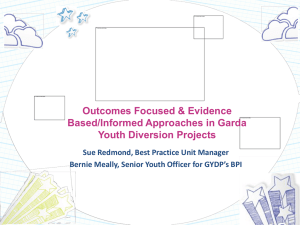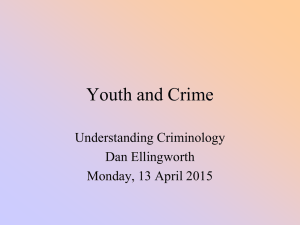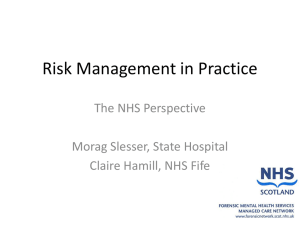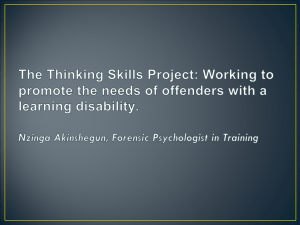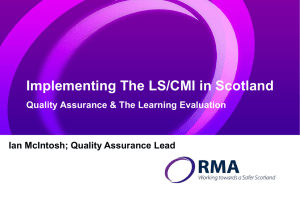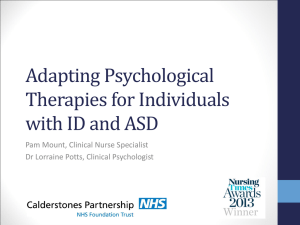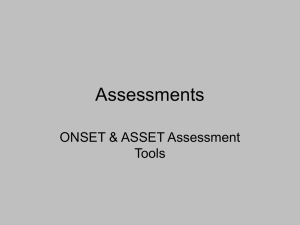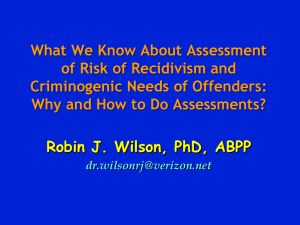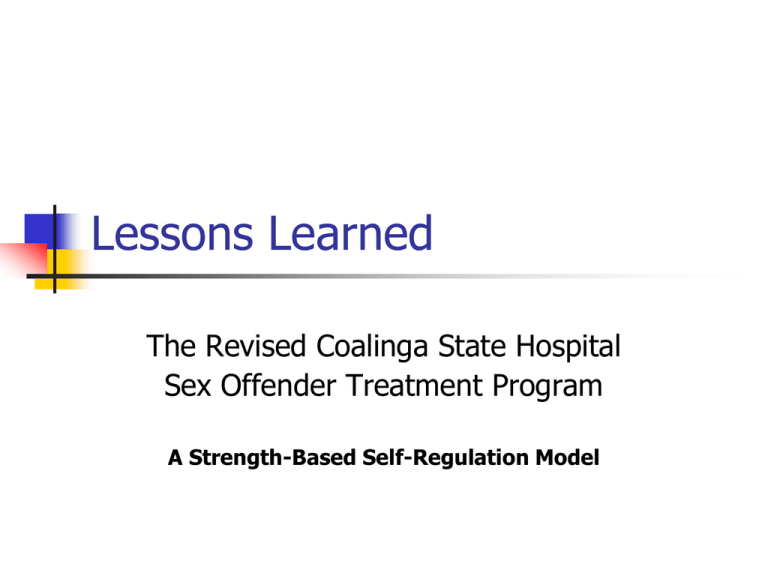
Lessons Learned
The Revised Coalinga State Hospital
Sex Offender Treatment Program
A Strength-Based Self-Regulation Model
Brief History of the CSH SOTP
Relapse Prevention (RP) Program Initially started at Atascadero
State Hospital
Relapse Prevention (RP) was most established program at that
time even though there was no empirical evidence for its
efficacy
Good "face validity"
Nothing else available that seemed to work
Had proven successful in alcohol maintenance programs
The Sex Offender Treatment and Evaluation Project (SOTEP)
completed and published in 2000 (Marques, Nelson, Alarcon, &
Day, 2000). Results indicated program was ineffective
"SOTEP researchers critiqued problems of RP (2005) Overmechanized and rigid
Brief History - continued
ASH SVP patients transferred to CSH starting in 2005
Any thoughts of changes delayed until after the transfer of all individuals
was completed.
Selected therapists from CSH were trained at ASH
Research regarding what works in treatment and how best to implement
treatment were subsequently published. New research exposed some
limitations of strict RP programs
"Enhancement Plan" implemented with oversight by Federal Government
required a rehabilitation philosophy (Wellness & Recovery)
Enhancement Plan became focus of program treatment changes
Compliance with EP was essentially met and energy refocused on
program revision (2011)
Why Change?
Improve Efficiency
Improve Effectiveness
Incorporate Research Developments
Increase Treatment Engagement
Important Research Developments
Suggesting Change
Limitations of RP Model
Risk, Need, Responsivity (Andrews &
Bonta, 2006)
Research on aging and recidivism
(Prektky & Lee, 2007; Hanson, 2005)
The Self-Regulation Model (SRM)
Evolution of Strength-based Models
Some Limitations of Traditional
RP
Limitations:
Designed for alcohol maintenance programs, not sex
offenders. Assumption is that individuals are motivated to
avoid offending.
Fails to account for heterogeneity of sex offenders. One size
fits all, not individualized. Assumes one pathway to
offending.
Focuses on risk factors (avoidance based) at the exclusion of
strength factors and positive goals.
Doesn't identify the existence of explicit approach goals,
active offense planning, or active pursuit of deviant sexual
interests.
*(Kingston, Yates, & Firestone, 2011)
Positive Aspects of RP
The required autobiography helps
identify predisposing factors and some
dynamic risk factors
Helps identify precipitating factors
Helps identify high risk behaviors and
situations and teaches avoidance
techniques and/or methods to cope
with high risk situations
Research Influencing
Change
Important Research Development:
Risk, Need, Responsivity
(RNR)
Andrews & Bonta's (2006) research on
criminal recidivism found three treatment
principles consistently reduced recidivism
Risk, Need, Responsivity Principles
*Andrew's & Bonta suggest several principles but
these are the three primary ones considered
important for all offender programs
Subsequently, Hanson, Bourgon, Helmus, and
Hodgson (2009) found that the same
principles that worked for criminal behavior
also worked for sex offender treatment
RNR Theory
RNR are components of treatment but the
theory itself doesn't provide a specific
framework for providing treatment
RNR Principles provide guidelines for other
models of treatment
Encourages individualized treatment based on
each individual's identified risk factors
Recommends focusing treatment on those
factors shown to be related to recidivism
RNR Principles
Risk: Match the intensity of treatment to the risk level. (Static &
Dynamic Risk Factors)
Conversely, don't provide treatment for an individual who doesn't
need it.
Need: Treatment should target dynamic risk factors associated
with recidivism that can be changed through intervention. Other
factors are discretionary
Responsivity: Refers to the treatment programs ability to teach
concepts based on individual learning styles, motivation levels and
in a manner that engages the individuals being treated.
These principles are now standard guides for evaluating treatment
programs.
Research indicated that the success of a treatment program is
directly related to the degree of adherence to these principles
(Hanson, Bourgon, Helmus, and Hodgson (2009).
IMPORTANT RESEARCH DEVELOPMENT
SELF-REGULATIONS MODEL
Important Development:
Evolution of The Self-Regulation Model
Devised specifically to address limitations of
RP model.
RP treatment assumes that everyone wants to
avoid offending (related to it being developed as a
maintenance program) and feels bad about it
when they do offend
SRM research (Laws et. al., 2000; Hudson, Ward
& McCormack, 1999; Ward, Louden, Hudson, &
Marshall (1995) found that many offenses involve
careful, systematic planning and are followed by a
positive emotional state
Self-Regulation Model (SRM)
Ward & Hudson (1998) developed the
SRM to better explain the offense
process and to guide treatment
SRM is derived from theories of:
Goal directed behavior
Decision making
Self-Regulation Model
Determining Offense Pathway
The pathways used to avoid offending or
to offend involve all of the following:
Self-Regulation Style
Goals with Respect to Offending
Strategies to Achieve Goals
Role of other goals involved in
Offending Behavior
SRM
Two Possible Goals Related to
Offending
Offending Goals:
Avoidance Goals: Goal is to avoid offending
Approach Goals: Goal is to offend
SRM
2 Types of Strategies to Achieve
Offending Goals
Dysfunctional Strategies
Under-regulation
Mis-regulation
Intact Regulation
*The combination of goals (approach-avoid) and
strategies used (dysfunctional and intact) creates 4
pathways to offending
Avoidant Pathways
Avoidant-Passive Characteristics
Avoidance goals
Under-regulated -- lack skills to prevent
sex offending
Passive and/or automatic strategies
Avoidant Active
Avoidance Goals
Mis-regulated strategies
APPROACH PATHWAYS
Approach-Automatic
Approach goal to offending
Under-regulated strategy (impulsive)
Generally feels satisfaction after offending
Approach-Explicit
Approach goal to offending
Intact self-regulation strategies
Feels satisfaction after offending
SRM PATHWAYS TO OFFENDING
Pathway
S-R Style
Description
Avoidant-Passive
Under-Regulation
Desire to avoid offending
but lacks coping skills to
prevent it.
Avoidant-active
Mis-regulation
Attempts to control deviant
thoughts and fantasies but
uses ineffective strategies
Approach-automatic
Under-regulation
Overlearned se3xual scripts
or offending, impulsive and
poorly planned behavior
Approach-Explicit
Intact - regulation
Desire to sexually offend
and offenses are carefully
planned
What Pathway Did Mr. A follow?
Mr. A has been convicted of 2 sexual offenses against boys less than 10 y/o. A previous
change for a similar offense was dismissed. All offenses involved fondling and fallatio and
were committed when Mr. A was between the ages of 15 & 23. He received probation for
the 1st offense and a prison sentence for the 2nd offense. He has no other criminal history.
Mr. A has a stable family history and supportive parents. He has never had a long-term
intimate relationship with an adult. He reports he has never engaged in sexual intercourse
with an age-appropriate female and that he is not sexually attracted to adult males. He
indicates he is shy and reluctant to establish age-appropriate relationships.
The offending incidents were similar. In the first, he encountered a prepubescent male
whom he manipulated to go to a park and then fondled and fellated him. He reported that
at the time he was unemployed and felt worthless. The 2nd offense was committed against
a neighbor's child whom he was babysitting. He reported the 1st incident to a school
counselor after which he "just wanted to forget" about the incident. Prior to the offenses
he had begun to masturbate to fantasies of boys and think about age appropriate females.
The strategy failed and he felt guilty about his sexual attraction to boys.
Mr. A Characteristics
Under-regulated -- Desires to avoid offending but lacks skills to
prevent it
He experienced a situation that included a negative affective
state which created a desire to offend
Disinhibition occurred and he lacked strategies to cope with the
situation that would have prevented him from offending.
*This pathway is often found in individual's with low selfefficacy expectations about their ability to avoid offending
What Pathway Does Mr. B
Follow?
Mr. B is a 40 y/o man who plead guilty to 6 counts of
sexual assault committed over a period of 8 years
against one victim, a boy between ages 10 & 18. He
maintained the abuse by convincing the boy that no
one would believe him if he reported the events.
He was previously arrested at age 19 when he
sexually assaulted a 14 y/o boy and again when he
was 26 and assaulted a teenaged boy. While
incarcerated in prison, he coerced sexual activity
from other inmates in exchange for helping them in
completing paperwork.
What Pathway Does Mr C
Follow?
Mr. C was arrested and convicted of two counts if
indecent exposure following an incident in which he
touched two girls on a train, during which he also
masturbated to ejaculation. He left the train an
approached another girl, with his penis exposed. He
intended to have the girls perform fellation on him.
Prior to the offenses, Mr. C had been drinking in a
bar and left when he was rejected by a female in the
bar. He subsequently boarded the train knowing that
there would be girls traveling on the train after
school.
What Pathway Does Mr. D
Follow?
Mr. D was convicted of touching his biological
daughter when she was 10 y/o. At the time
he was working in a country with a very hot,
humid climate where family members were
frequently partially clothed as a result of the
weather. One day, in this situation, he
became aroused to his daughter. He realized
his arousal was inappropriate and attempted
to avoid high risk contact with her. He was
usually successful but on some occasions
engaged in fondling his daughter.
Treatment Implications of
Pathways
Different treatment recommendations
are recommended for different
pathways
Offense Progression steps replaces
cycle of abuse used in RP
Research indicated that the risk is
higher for those who have approach
pathways compared to those who have
avoidance pathways
Offense Progression - 10 Steps
Purpose: Examines Offense pathways in detail
Replaces RP cycles of abuse
Step
Step
Step
Step
Step
Step
Step
Step
Step
Step
1: Preconditions to offending
2: Life Event
3: Desire in response to life event
4: Goal Establishment
5: Strategy Selection
6: Opportunity to Achieve Goals
7: Pre-Offense Behaviors
8: Commission of Sexual Offense
9: Post Offense evaluation and adjustment of future offending plans
10: Future intentions and adjustments of future goals
10 Step Process Example
Avoidant-Passive
Mr. Z was very shy and interpersonally awkward growing up but eventually
married. (Predisposing). However, Mr. Z was recently separated from his
spouse after being convicted for child sexual abuse. He attends treatment and
is avoiding high risk situations. But, he has an argument with his girlfriend and
feels rejected by her (life event). As his moods worsens he begins to fantasize
about having sex with a teenage girl down the road (desire for deviant sex).
He realizes these thoughts are not good for his goal of not offending
(avoidance goal established) but continues to have the fantasies which
makes him very anxious. He decides to avoid the thoughts by watching
television (strategy selected). This doesn't work and he feels out of control.
Over the next few days he goes on daily walks down the girl'[s street for
"exercise" and one day "accidentally" runs into the girl and strikes a
conversation with her (high-risk situation). He feels anxious and out of
control and suggests to the girl that they go for a walk in the park (lapse). He
is now filled with pleasurable anticipation. He molests the girl (relapse).
Afterward, he is filled with remorse and self-disgust (Post offense
evaluation). He resolves to never offend again (attitude toward future
offending).
Treatment Interventions
Avoidant Passive
Develop coping skills that allow for
regulation of emotions and dis-inhibited
behaviors and cognitions that
accompany loss of emotional control
Adjust treatment plan to address
attributions of powerlessness
Develop pro-social ways to achieve
goals associated with offending
Treatment Interventions
Avoidant Active
Strengthen and improve ineffective
coping skills
Re-work treatment plan to increase
awareness of flawed perceptions of
effectiveness
Develop pro-social ways to achieve
abstract goals associated with offending
Treatment Interventions
Approach Automatic
Develop coping skills for self-regulation
Emotional regulations
Behavioral regulation
Cognitive regulations
Address issues of hostile/entitled or criminal
schemas
Rework treatment plan to address offense
supportive beliefs associated with impulsive
behavior
Develop ways to achieve secondary goals
associated with offending (e.g., relatedness)
Treatment Interventions
Approach - Explicit
Address pre-disposing issues that may have
contributed to anti-social goals
Modify hostile/entitled or criminal schemas
Adjust treatment plan to address offense supportive
beliefs related to anti-social behavior
Expand scope of pro-social meaningful and
preasurable activities (Note VIA-IS tests)
Develop ways to achieve secondary goals sought
through offending in pro-social ways (e.g. mastery)
Strength Based Approach
Implementing Strengths into Treatment
RECENT DEVELOPMENTS
Integration of Normative Goals
into Treatment
The use of Wellness & Recovery philosophy is
mandated by the Enhancement Plan. This
model requires incorporation of strengths into
treatment plans
Directs focus onto both addressing risks and
strengths. Focus on the "future me" utilizing
strengths, values, and interests
Strengths are identified by the Values In Action
assessment
Increase attention to pro-social goals rather than
focusing entirely on avoidance goals. The
problem of "narrow scope"
Focus on benefits of positive treatment change
Relationship of other goals to
Offending
Offending sometimes occurs in the process of achieving
normal human goals in flawed ways. Individuals use
inappropriate strategies to obtain goals
Narrow scope of interests
Conflicts among goals, e.g., want a relationship but also
wants to feel autonomous resulting in over-controlling
relationships
Lack of internal or external capabilities (lack of skills or
opportunities to achieve normal relationships)
Treatment focuses on reducing risk via improving selfregulation, by targeting identified dynamic risk factors for
treatment, and by increasing ability to achieve normal
human goals in a pro-social manner
Treatment is a means to improving personal functioning
COMMON HUMAN GOALS
Life
Knowledge
Excellence in work and/or play
Excellence in agency (autonomy)
Inner Peace
Friendship
Community
Spirituality
Happiness
Creativity
Problems in Attaining Goals
Lacks means to attain goals
Lacks scope of pleasurable activities in
daily living
Conflict among goals
Lack of capacity to attain goals in
acceptable manner
Integrating Strengths into the
Self-Regulation Model
Yates and Laws:
Felt that the SRM didn't sufficiently address
strengths but was the best cognitive behavioral
program available
Integrated strengths and positive goals into the
Self-Regulation Model with the dual goals of
reducing risk and improving strengths
Postulates that this will increase treatment
engagement and will improve treatment effects
that will last longer since most people wont' want
to pursue avoidance goals for the remainder of
their lives.
Expected to increase treatment engagement
Individualizing Treatment
Avoidant/Passive Pathway
Assessment of stage of change prior to commencing
treatment
Target long-term vulnerability factors (DRFs)
Identify high risk situations that trigger offense
progression and the manner that the individual
perceives these events based on core beliefs and the
nature of the desire for offense-related behaviors
Increase the offender's awareness of the manner in which
he interprets events
Determine what he desires to achieve
Link offense-related experiences to vulnerability factors
DRFs function as markers for problems in important domains
Reinforce avoiding offending
Individualizing Treatment
Avoidant/Active Pathway
This is a mis-regulation pathway. Strategies to avoid offending
are ineffective
Strategies may increase risk of offending
Treatment focuses on examining the factors that make the
person vulnerable
Identify individual's high risk situations
Analyze the individual's interpretation of events based on core
beliefs
Case formulation should reflect the relationship between life
events, DRFs, and the offender's life goals
Treatment is focused on the strategies selected to achieve the
goal of avoiding offending and expanding the individuals scope
of interests
Generate strategies that would have been effective
Rehearse the strategies (role play)
Extinguish ineffective strategies
Improve problem solving
Individualizing Treatment
Approach/Automatic Pathway
Involves under-regulation or impulsivity with the
desire to offend
Individual responds to situational cues
(opportunistic)
Generally lacks interest in the needs of others
Responds to long standing scripts
Treatment focuses on raising awareness, altering
over-learned cognitive and behavioral scripts
Changing offense related goals
Individualizing Treatment
Approach/Explicit Pathway
Has intact regulation
Consciously and explicitly plans offenses with well-developed
strategies
Experiences positive emotional states from offending
Cognitive scripts include a sense of entitlement, hostile attitudes
toward a specific group or the world in general, beliefs that sexual
abuse is acceptable.
Treatment focus includes changing goals with respect to behavior
Identify other human goals being sought when offending
Raise awareness
Exam historical events that led to beliefs that support offending
Establish what needs the offender is trying to meet
Motivate offender to instill the idea he can meet these needs in prsocial ways
Cognitive therapy for changing belief system
Reduce the sense of entitlement
Treatment Program Revision Goals
Improve EFFICIENCY, EFFECTIVENESS, AND ENGAGEMENT of
treatment program participants
Adhere to RNR concepts
Eliminate phases of treatment and replace with treatment targeted for each
individual based on risk factors and needs (per RNR)
Focus on research supported treatment targets individualized for each
individual (per RNR)
Follow established learning theory principles for skills acquisition (see
learning principles)
Revise assessment procedures and eliminate unnecessary assessments,
especially those shown not to predict recidivism (per RNR)
Include positive goals in treatment to increase treatment engagement
(Responsivity of RNR principle)
Identify strengths (VIA-IS) and integrate into treatment (Responsivity)
Increase treatment engagement (currently 33% participate in phase
treatment) via all of the above
Goal: RNR ADHERENCE
Risk: The risk level is identified by the administration of the
Static 99-R to assess Static Risk factors and the administration
of the SRA to assess dynamic risk factors. This combination
along with overall history determines treatment intensity.
Need: The identified dynamic risk factor (need) associated with
recidivism become the primary treatment targets. Specialized
groups are provided to address the various risk factors.
Responsivity: The revised program provides several
motivational modules at the beginning of treatment and
sequences treatment in a manner designed to increase
treatment engagement. Assessments are provided for strengths
(VIA-IS), protective factors, and vocational interests along with
the risk assessments. A separate manual is being constructed
for those with learning difficulties that presents information in
an easy to understand manner. The adopted model is
specifically designed to individualize treatment and to increase
motivation for treatment and engagement.
Goal: Improve Efficiency of SOTP
WHY REMOVE PHASES?
One size fits all, not individualized
Risk oriented with no focus on positive goals
Inefficient
Ignores learning theory principles for best ways to
learn
Unnecessary tedious assignments not shown to
enhance treatment outcomes
Targets factors that haven't been shown to be
related to treatment outcomes
Apply Principles of Learning
Readiness
Exercise
Effect
Primary
Recency
Intensity
Freedom
Requirement
Target Factors Related to Recidivism
Empirically Identified Risk Factors
Mann, Hanson, and Thornton (2010) -- Identified meaningful
and empirically supported risk factors for treatment
Sexual Preoccupation
Deviant Sexual Interest
offense Supportive Beliefs
Emotional Congruence with Children
Lack of emotional Adult Intimate Relationships
Lifestyle Impulsivity
General Self-Regulation Problems
Poor cognitive Problem Solving
Resistance to Rules and supervision
Grievance/Hostility
Negative social influences
Target Factors Related to Recidivism
Promising Risk Factors
These factors are promising but
insufficient research has not yet been
established
Hostility toward woman
Callousness/ lack of concern for others
Dysfunctional coping
Sexualized coping
Target Factors Related to Recidivism
Unsupported risk factors with some
exceptions
Denial*
Thornton & Knight found denial to be a protective
factor
Maruna & Mann (2006) noted that deniers in
parole hearings have lower recidivism
Hanson & Bussiere (1998) found no relationship
between denial and recidivism
Low Self-Esteem* Studies that used SSES and
SSEI found results to be predictive
Major mental illness
Loneliness
Don't Target Factors Unrelated to Recidivism
NOT IDENTIFIED AS RISK FACTORS
Social skills deficits
Poor victim empathy
Pre-treatment lack of motivation for treatment
* CSH emphasizes social skills deficits and victim
empathy in Phase treatment. I.e., it targets factors
not shown to be related to recidivism. Make these
groups optional based on clinical need.
Lesson Learned: Ensure that treatment facilitators
focus on relevant treatment targets.
Improving efficiency
Apply learning theory principles
Phase 2 is called Skills Acquisition. This is primarily RP. Phase 3 is called Skills
Application. Learning theory indicated that the best way to learn new skills is
to practice skills while you are cognitively learning them. The new program
will teach skills (formerly Phase 2) and have individual's practice and record
their progress in applying skills at the same time. A separate "Core Group"
(formerly Phase 3) will be conducted to discuss the application of skills and to
receive feedback on their progress. Essentially, this is conducting the
functions of Phase 2 and Phase 3 simultaneously
An additional benefit is that individuals will remain in the same group from
matriculation to release. This will keep individuals from adjusting to new
facilitators when they switch phases and will help facilitators have a better
vantage point from which to judge improvement.
Improving Assessment
Procedures
Do not assess for traits that have not been
shown to be related to recidivism (e.g.,
empathy)
Include assessment of protective and
strength factors
Eliminate unnecessary and expensive
assessment tools. Several of the
assessments that were routinely administered
are now used only as needed (eg., MMPI,
MCMI,Empathy).
Consider recent literature on the effects of
aging when assessing risk.
Pre and post-tests for all DRF groups.
Summary of Goals For Revised SOTP
Adhere to RNR concepts
Reduce treatment elements not supported by research
Follow learning theory principles for administering groups
Focus research supported treatment targets individualized for
each person
Replace current RP model with Self-Regulation Model
Conduct skills acquisition groups (currently Phase 2) with skills
applications groups (aka, "Core Groups") (Formerly Phase3)
during the same time periods.
Assessment Procedure Goals
Summary
Minimize use of pathologically oriented tests not shown to relate
to recidivism
Add strength based assessments to help inform release planning
and to increase treatment engagement
Incorporate research evidence for the effects of aging when
assessing risk
Adopt SRA for DRF assessment to align with CDCR
Complete periodic stages of change ratings for dynamic risk
factors and incorporate into charts
Adapt the SOTIP rating scales to the hospital population to get
treatment improvement ratings for every 6 months
Use the Therapist Ratings Scales (Marshall) to be used after one
year and every two years thereafter
Pre-post tests for all DRF and relevant groups
Proposed Changes to Increase Efficiency
Eliminate Phases
Phase 1 becomes treatment readiness group.
The Strength Based Self-Regulation Modules and Core groups replace
Phase 2 and 3 which are essentially combined.
Unlike RP, the SRM is specifically designed for sex offender treatment.
Core groups are established at time of entry into treatment and essentially
function as the Phase 3 application of skills groups. Core groups commence
as soon as treatment is started and the individual stays in the same group for
the duration of his treatment
Create targeted treatment that retains positive parts of phase program but
individualizes treatment
Current DRFs addressed in treatment are not shown to be related to
recidivism
Preparation for release begins after completion of the SRM modules and
the majority of DRFs are successfully addressed. A group for planning
for release will be established and will replace Phase 4.
Release Criteria
Completion of Self-Regulation Modules
Demonstration of successful changes in dynamic risk
factors
Core facilitators and team have completed Treatment
Rating Scales and have recommended release
Utilize SOTIP scales for 6 month evaluations and to
inform the TRS raters
Measure stages of change for each individuals risk
factors
Prepare for release to CONREP
CONREP program established and individual agrees
to outpatient care
Increasing Treatment
Engagement
Target both strengths and risks in
evaluations
Replace RP with Strengths Based SRM
Includes a focus on strengths and risks
Allows for better individualized treatment
Designed specifically for sex offenders
QUESTIONS?

